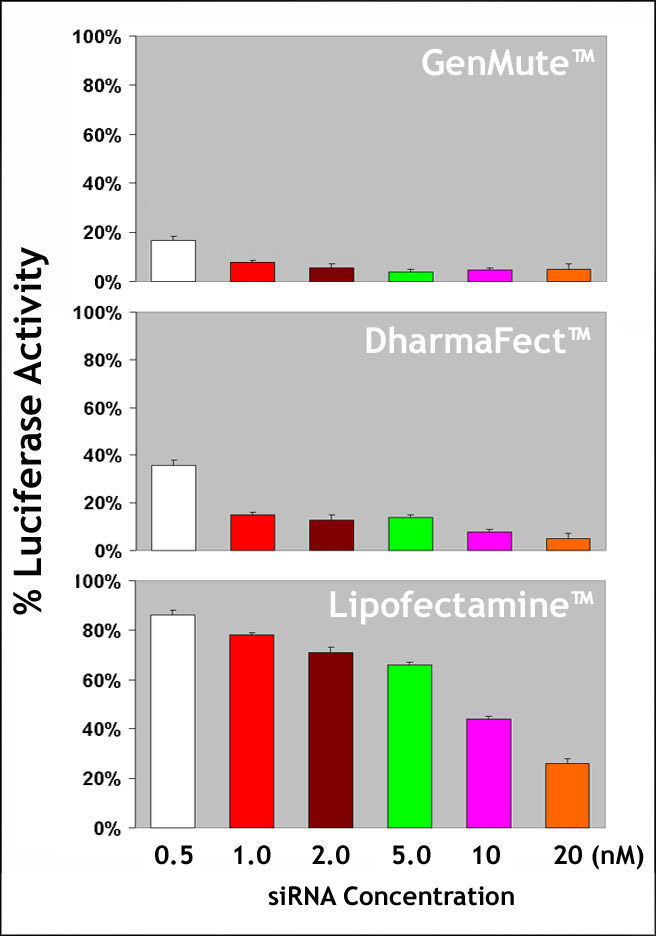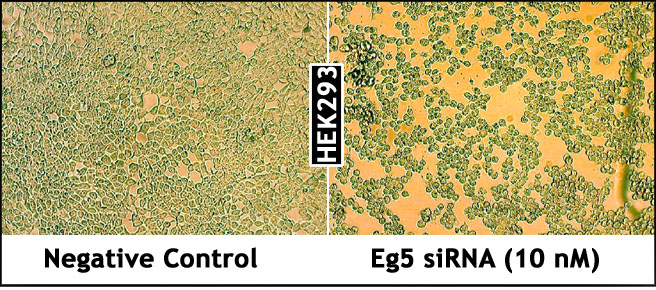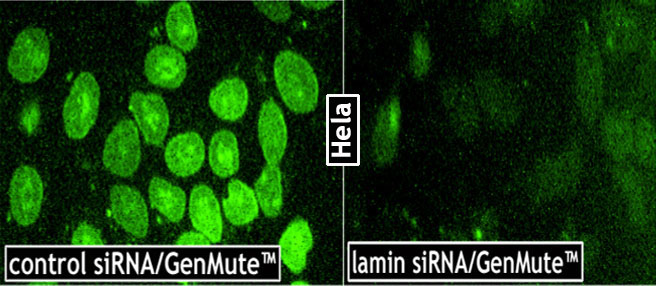EGFIE LLC
We always add value to our customers
Search by Keyword
Product Categories
Small interfering RNA (siRNA), sometimes known as short interfering RNA or silencing RNA, has a well-defined structure: a short (usually 21-nt) double strand of RNA (dsRNA) with 2-nt 3' overhangs on either end. siRNAs can be introduced into cells by various transfection methods to bring about the specific knockdown of a gene of interest. Essentially any gene of which the sequence is known can thus be targeted based on sequence complementarity with an appropriately tailored siRNA. This has made siRNAs an important and indispensable tool for gene function and drug target validation studies in the post-genomic era.
While liposome or polymer reagents often give very good DNA delivery efficacy, they often failed to efficiently drive siRNA into mammalian cells due to the length of the siRNA anionic segment that is too short to maintain electrostatic cohesion with the cationic lipids or polycationic polymer. We modified the liposome and polymer by addition of specific pre-screened hydrophobic groups which confers the pH dependent conformational changes (PDCC) at physiological pH condition and greatly stabilizes siRNA lipolplex or polyplex.
Based on our unique and proprietary “PDCC” technology, currently we are developing and manufacturing the following four siRNA transfection reagents, which show distinct transfection characteristics with the leading products in the market.
siRNA Transfection Reagent Selection Chart.
| Reagents | Features | Transfection Type | Toxicity |
| - PepMute™ | - Exceptional good for siRNA transfection - OK for DNA/siRNA co-transfection |
siRNA DNA/siRNA |
++ |
| - GenMute™ | - Exceptional good for siRNA transfection - Excellent for DNA/siRNA co-transfection |
siRNA DNA/siRNA |
++ |
| - PowerFect™ | - OK for siRNA transfection - Excellent for DNA transfection - Excellent for DNA/siRNA co-transfection |
DNA DNA/siRNA |
+ |
| - PepMute™ Plus | - Exceptional good for siRNA transfection - Excellent for DNA/siRNA co-transfection |
siRNA DNA/siRNA |
++ |
Description:
GenMute™ Reagent is a novel biodegradable non-liposomal siRNA/miRNA & DNA delivery tool. With our proprietary pH Dependent Conformational Change (PDCC) technology, the biodegradable transfection reagent was formulated by addition of pre-screened hydrophobic groups to its side chain, making GenMute™ Reagent a versatile and most powerful gene delivery tool in the market. GenMute™ Reagent have been validated to effectively and reproducibly transfect single siRNA/miRNA or co-transfect DNA/siRNA or DNA/miRNA to variety of mammalian cells.
Size & content:
- GenMute™ Reagent, 1.0 ml, sufficient for ~2,000 reactions based on transfecting 5.0 pmol siRNA or miRNA mimics in 24-well plate
- GenMute™ Transfection Buffer (5x ), formulated for maximal transfection efficiency, 8.0 ml to make 40 ml working solution
Applications:
- Single siRNA transfection or DNA/siRNA co-transfection to variety of mammalian cells
- Single miRNA, miRNA mimics or inhibitors transfection or DNA/miRNA or DNA/miRNA mimics co-transfection to variety of mammalian cells
Storage:
Store at 4 °C. If stored properly, the product is stable for 12 months or longer.
Advantages:
- Excellent silencing at low concentrations with only 1.0 nM siRNA / miRNA mimics
- Minimizing non-specific and off target effects in the cell
- One tube reaction
- Best for broad mammalian cells
- Very low cytotoxicity
- Very affordable
Comparisons of Silencing Efficacy of GenMute™ siRNA & DNA Transfection Reagent with Brand Name Products

Knockdown efficacy comparison of GenMute™ Transfection Reagent (upper panel) vs. Dharmafect™ 4 siRNA Transfection Reagent (middle panel) and Lipofectamine™ 2000 (lower panel) on HEK293 cells. siRNA targeting renilla luciferase at different final concentrations ranging from 0.5 to 20 nM was co-transfected with renilla luciferase gene (0.5 µg of pRL-CMV DNA per well) by the above three transfection reagents per manufacturers' protocols into HEK293 cells growing on a 24-well plate. Renilla luciferase activity was determined 24h after post co-transfection with renilla luciferase determination system (Promega). The luminescence was measured from 5.0 µl of lysate during 10s integration with a luminometer (Beckman Coulter LD 400). Luciferase activity was expressed as light units integrated over 10s (RLU) and normalized per mg of cell protein by using the BCA assay. The errors bars represent standard deviation derived from triplicate experiments. Luciferase-silencing efficiency was calculated relative to untreated cells. While GenMute™ and Dharmafect™ 4 reagents delivered significant gene silencing from 1.0 nM of renilla luciferase siRNA, lipofectamine™ 2000 gave good knockdown only after 30 nM (data not shown).

Excellent silencing of endogenously expressed KIF11 (also known as Eg5) in HEK293 cells with 0.5 µl of GenMute™ reagent and 5.0 pmol Eg5 siRNA per well of 24-well plate. KIF11 (also known as Eg5) encodes a motor protein that belongs to the kinesin-like protein family involved in chromosome positioning and bipolar spindle formation during cell mitosis. A reduction in KIF11 levels causes mitotic arrest. GenMute™ reagent effectively delivers Eg5 siRNA (final 10 nM, right panel) to HEK293 cells at only 0.5 µl per well of 24-well plate vs. negative control (final 10 nM. left panel). Compared with negative control (left panel), phenotype of "rounded-up" 293 cells were visualized 24 hours post transfection (right panel) with a Nikon microscope.

GenMute™ Transfection Reagent knocked down endogenous lamin A/C gene expression in Hela cells. A siRNA targeting lamin A/C gene (right panel) and a sham siRNA (left panel) were introduced into Hela cells (final 1.0 nM) byGenMute™ Transfection Reagent. Lamin A/C gene silencing was monitored 24h post transfection by immunofluorescence. Lamin A/C was probed with a mouse monoclonal lamin A/C specific antibody followed by addition of FITC-conjugated anti-mouse antibodies. Quantitative analysis showed that lamin siRNA at 1.0 nM delivered by GenMute™ Transfection Reagent knocked down 94% endogenously expressed lamin A/C in Hela cells.
Data Sheet & Protocol
- A Protocol for siRNA Transfection and DNA/siRNA Co-Tranafection ![]()
- A Protocol for miRNA Mimics Transfection and DNA/miRNA Co-Transfection ![]()
- A Protocol for DNA Transfection to Mammalian Cells ![]()
Shopping Basket
| Items: | 0 |
| Subtotal: | $0.00 |
customer@egfie.com